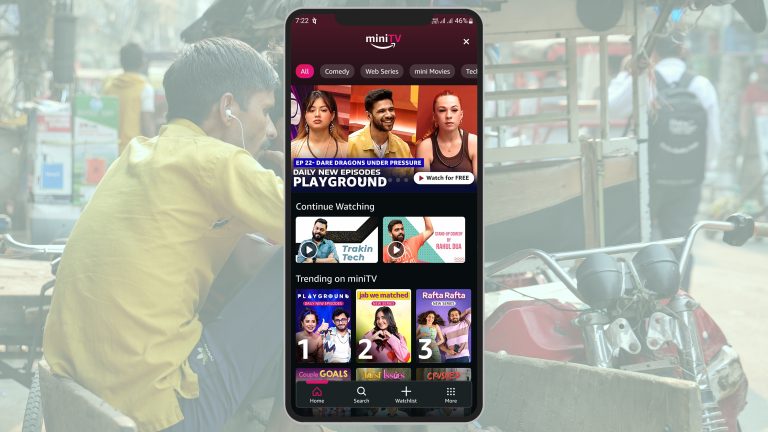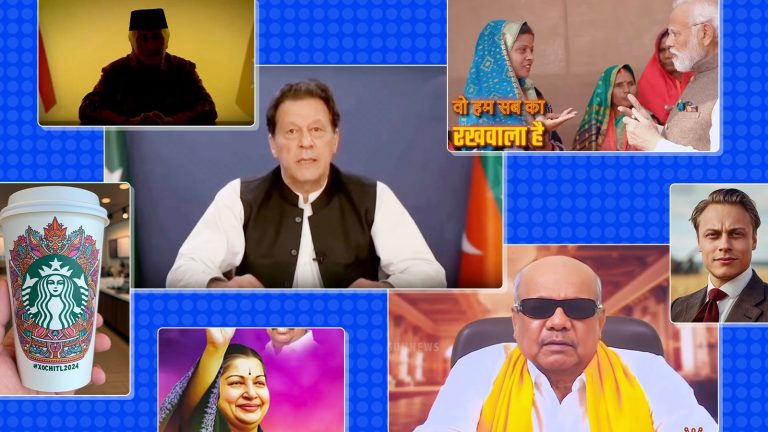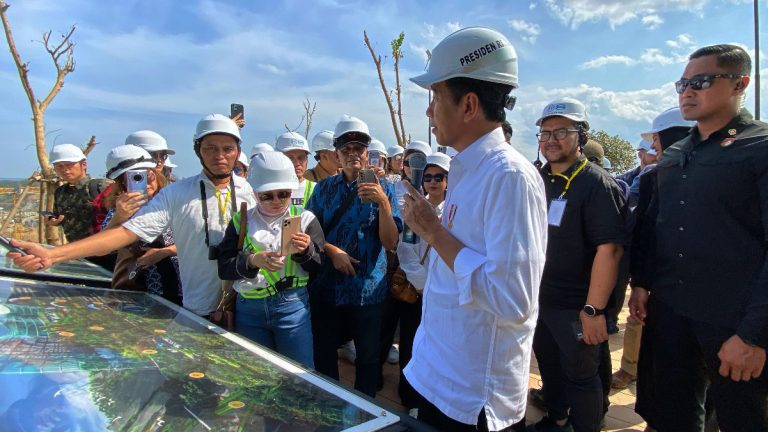Amazon chairman Jeff Bezos famously said that every time an Amazon Studios production wins a Golden Globe, it helps the company’s e-commerce arm sell more shoes. He was describing Amazon’s “flywheel” strategy, where users who are Prime subscribers shop more, browse more, and watch more of the platform’s award-winning content in order to make the most of their membership.
In India, Amazon is experimenting with a new but similar content-to-commerce strategy through miniTV, an ad-supported streaming service inside its shopping app. The hope is that it will lure young audiences with free content, eventually turning them into online shoppers, former and current company executives told Rest of World. They requested anonymity as they were either not authorized to speak to the media or had signed non-disclosure agreements.
Launched in May 2021, miniTV hosts a range of content including miniseries, serialized comedy skits, gadget reviews, food and fashion videos, and clips from internet influencers. At the time of launch, miniTV’s content portfolio was geared towards young adults between the ages of 18 and 25 years who could not afford subscriptions, a senior Amazon executive told Rest of World. Today, Amazon has put miniTV front and center on its shopping app in India. So far, leading digital entertainment studios, such as TVF and Pocket Aces; Indian internet celebrities including Kusha Kapila, Bhuvan Bam, and Ajey Nagar (CarryMinati); and BBC Studios have or are in the process of producing content for miniTV.
Though all it takes to consume miniTV is an Amazon login, the free service has yet to take off in the way the company had anticipated, according to a former Amazon executive in the know. “MiniTV is still in search of its Mirzapur,” they told Rest of World, referring to Prime Video’s Hindi-language crime thriller that had been one of the most-watched Amazon series in India in 2020. The company had set an internal target to reach 2 million daily active users by December 2022, which was met in some months and missed in the others, the executive said.
But even as Amazon shut down unprofitable India experiments, such as food delivery and edtech businesses, due to unfavorable economic conditions in 2022, it continues to invest in miniTV because of its promising results, the former executive said. “MiniTV has proven some of the initial business hypothesis — it is leading to low cost of customer acquisition, customers who start on miniTV tend to shop more on Amazon,” a senior Amazon executive told Rest of World. If it works, the executive said, miniTV would become a cost-effective way to acquire customers — instead of directly putting money in TV ads.
“If that hypothesis continues to play out, I will not be surprised if you start seeing other countries also having miniTV in the Amazon shopping app,” the senior executive added. Under the name Freevee, Amazon operates a similar standalone ad-supported app in the U.S., U.K., and Germany.
The year “2022 was miniTV’s first full year of operation and the results have been highly encouraging,” an Amazon miniTV spokesperson said, in response to queries sent by Rest of World. “Not only have we received a lot of positive feedback from our customers and advertisers, but our strong content has received industry recognition as well.”
“Now, it’s more of comedy, drama and getting into web series.”
According to the spokesperson, there’s a two-fold vision for miniTV: engage with Amazon’s large customer base across India with free, high-quality content, and provide brand partners and advertisers a platform to reach a bigger and more engaged customer base. Amazon did not want to comment on Rest of World’s specific questions about the daily user count and miniTV’s impact on reduced customer acquisition cost.
MiniTV executives have made quick changes to the content based on market feedback. “I think when we started out, we did a lot of influencer content with food and beauty. That is something that they have kind of moved on from — lifestyle kind of things,” said another former employee who was aware of the deliberations around content strategy. “Now, it’s more of comedy, drama and getting into web series.”
With every successful show, miniTV’s content strategy is changing, Abhishek Dhandharia, founder of Mumbai-based production house About Films and creator of the hit miniTV show Physics Wallah, told Rest of World. “Now [miniTV’s] looking into every genre of content. Three months back, they used to tell me we are only looking for content … which caters to younger audiences. But now, they are looking into more serious content, and every kind of content. I think Physics Wallah has given that proof of concept,” he said.
Each episode of Physics Wallah — a web series based on the real-life story of a YouTube teacher — has a runtime of 50 minutes, breaking away from miniTV’s playbook of short (15-30 minute) episodes. The show turned out to be a critically-acclaimed hit, ranking number four on the list of the 15 most-liked Hindi shows of 2022, according to a report by media consulting firm Ormax Media.
Over the past two years, miniTV has experimented with a wide range of content with moderate success: Its series, such as Aspirants, Farzi Mushaira, Crushed, and Sixer, include some of the successful shows the studio has renewed. Case Toh Banta Hai, a sketch comedy show set in a courtroom featuring Bollywood celebrities, was one which “brought in a lot of customers” for miniTV, the senior executive said.

“We are experimenting with multiple content types and genres to see how our viewers react and accordingly feed those signals in our content offering,” the miniTV spokesperson said in response to Rest of World’s queries on its changing content strategy.
Wider adoption of miniTV could mean a new revenue stream for Amazon, opening up new ad inventory and formats. In India, free, ad-supported streaming generates more revenue than the subscription-based model, and is expected to reach $2.4 billion in 2026, according to a report by Deloitte.
Netflix had introduced a low-priced service in its bid to attract new users in India, but the ad-supported service remains unavailable in the country. Local streamers Zee and Voot also have ad-supported plans. YouTube and MX Player, a service that operates in the same space, lead the market, ahead of Netflix and Prime Video. Amazon is keen to cement its position in the ad-supported streaming market — according to TechCrunch, it wants to buy MX Player.
“Every [streaming platform] now in India is trying ad-based revenue,” said Dhandharia of About Films. “Indians want everything for free. They can pay by their time, but they don’t want to pay money.”
MiniTV has already tried product placement in its content, and is currently testing a new ad format where it showcases ads without interrupting the show, two Amazon executives told Rest of World. For instance, if the show is showing someone going inside a grocery store, users might see “nudges” to purchase from certain brands. While the miniTV spokesperson did not comment specifically on the nudges feature, Amazon said it recently launched mobile shoppable ads on miniTV. As the advertisement plays on miniTV, the landing page of the advertised brand opens below the player — the spokesperson said they’ve received high engagement on this new format.
“Indians want everything for free. They can pay by their time, but they don’t want to pay money.”
MiniTV can offer advertisers a valuable platform to reach consumers, and thereby grow its advertising business in India, Uday Sodhi, senior partner at Kurate Digital Consulting, told Rest of World. Amazon’s ad business is among its fastest-growing properties, and miniTV gives the company more inventory to play with.
Before miniTV, Amazon lacked a foothold in the video advertising space, while its local competitor Flipkart offered a free video service. There was an opportunity to leverage Amazon’s fully developed content creation ecosystem, available so far only to Prime members, and offer it to non-Prime members.
“It’s complementary to Prime,” said the senior executive, who had knowledge of the thought process behind miniTV. Because it is hosted inside the main shopping app, miniTV could enable Amazon to “acquire new customers who are still not ready for e-commerce, but obviously [use] the internet for video streaming.”
Nikhil Taneja, co-founder of Yuvaa, a Gen Z-focused media organization producing socially conscious entertainment, was first approached by miniTV in 2021. By the following year, Yuvaa had already put out two short films on miniTV, with a turnaround time of three to four months. “[It’s] quite fast for any platform, I’ll be honest,” Taneja told Rest of World. For miniTV, Yuvaa made Gray, a film on consent; and Tasalli Se, a short film on social media polarization. Both productions have gone on to win awards. Taneja said that miniTV is moving away from one-off short films towards web series and episodic content that keeps people coming back.
Additionally, Amazon’s own sellers have huge advertising budgets for the platform, Sodhi said, which the company can mine for ad revenue on miniTV.
“This seems to be a great strategy for consumers to come into the Amazon habit through video, and then [have the company] be able to retain them either through shopping, commerce, music, and through whatever they want to offer going forward,” he added. But it’ll take a while for this “flywheel” to fly.



